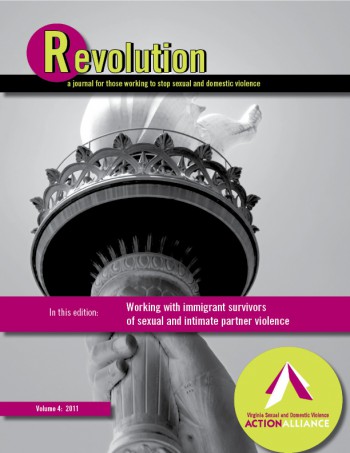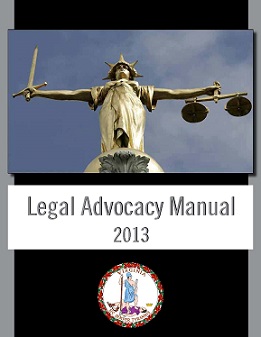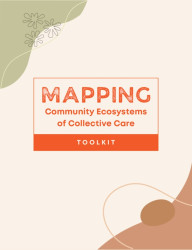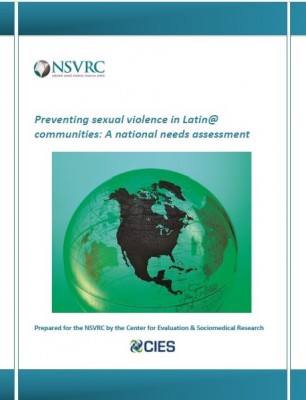Resources Library: Community Coordination & Collaboration
Start a Search:
Journal: Revolution: Working with Immigrant Survivors of Sexual and Domestic Violence

A journal for professionals working with victims/survivors of sexual and domestic violence. Volume 4 addresses working with immigrant survivors, and includes the following topics: Improving Your Program's Accessibility to Immigrant Survivors; Legal Clinics Help Immigrants Understand Their Rights; Immigrant Programs and Services; Power and Control Tactics Used Against Immigrant Women; Cultural Proficiency Continuum.
Volume 4; January 2011.
Published by Virginia Sexual & Domestic VIolence Action Alliance.
24 pages.
Legal Advocacy Manual 2013

The Legal Advocacy Manual provides victim advocates (as well as victims) with a comprehensive guide to help domestic and sexual violence victims in Virginia through some of the legal processes in which they may become involved. It provides both basic and intermediate levels of information about legal advocacy--what it is, the difference between civil and criminal justice systems, definitions of commonly used legal terms, and how to avoid the unauthorized practice of law, among other topics. The manual offers context for the emotional, logistical, and legal hurdles involved in protective orders, criminal prosecutions, visa applications, and divorces. It is 76 pages long and is in PDF form. Susheela Varky of Virginia Poverty Law Center updated it in June 2013 for recent changes in the law. Ms. Varky has used the manual as a resource for in-person trainings geared to victim advocates, and is available to tailor such trainings for your local Virginia domestic or sexual violence program.
Mapping Community Ecosystems of Collective Care

By Shannon Perez-Darby and Andrea J. Ritchie
Since the 2020 Uprisings, there has been an explosion of interest, activity, and organizing around community-based approaches to building safer communities free from the violence of policing. Throughout this period, Interrupting Criminalization has been supporting these efforts by sharing expertise built over decades of organizing for and practicing transformative justice-based approaches to building liberatory communities with resources, toolkits, webinars, podcasts, skill-shares, trainings, cohorts, and learning and practice spaces.
In many of these spaces, and within broader campaigns and movements to divest from policing and invest in the building blocks for safer communities, critical questions and conundrums began to surface from organizers. At the core of these concerns are the questions of:
- How do we build shared definitions, values, and practices of safety across neighborhoods and organizations working within a city?
- How do we weave our small, often relatively new community safety projects — ranging from mutual aid formations, to transformative justice practitioners, to neighborhood defense organizations, to community fridges, to violence interruption and crisis response teams operating at hyper-local levels — into robust, palpable neighborhood and city-wide ecosystems of care that people can feel, trust, and rely on more fully to collectively build greater safety and wellbeing?
- How do we relate to state institutions and resources as we are doing so?
This toolkit offers some resources, responses, and additional questions to consider based on our work and practice spaces.
In particular, this toolkit emerges from the work of our Creating Community Ecosystems of Collective Care Cohort, which launched in March of 2022 and featured over a dozen organizations working in community safety coalitions in Miami, Durham, NC, Seattle, Milwaukee, Phoenix, Minneapolis, and Atlanta. This cohort consisted of groups who were already engaged in this work; it was designed as a virtual space for organizers to learn, practice, and strategize together toward building more robust community ecosystems of care at the neighborhood and city-wide levels.
In addition to breaking isolation, cross-pollinating across communities, and creating a virtual community of practice, the goal was to collectively create resources to support communities beyond the cohort who are grappling with similar questions. This toolkit is that vision come to life.
As communities face increased policing, criminalization, and organized abandonment; mounting state violence, repression, and authoritarianism; escalating white supremacist, homophobic, and transphobic violence; and climate collapse; building skilled, coordinated, expansive, and robust ecosystems of collective care is only becoming more and more essential to collective survival.
Maternal Mortality Review – Each Death Matters
Virginia’s multidisciplinary Maternal Mortality Review Team reviewed nearly 400 cases of pregnancy-associated death occurring between 1999 and 2007. This brief article was published by the National Women's Health Network and authored by Victoria M. Kavanaugh, RN, PhD, Maternal Mortality Review Team Coordinator with the Virginia Department of Health, Office of the Chief Medical Examiner. In the article, Dr. Kavanaugh summaries Virginia data and emphasizes the need for maternal mortality reviews as a means to develop recommendations for interventions and prevention strategies to prevent future deaths. These recommendations apply to a wide array of fields, including prenatal health care, social work, psychiatry, emergency care, dietary services, health care, and advocacy.
Preventing Sexual Violence in Latin@ Communities: A National Needs Assessment

A significant proportion of people living in the United States are of Latin@ origin – about 16%, or 50.5 million, as of 2010 (U.S. Census Bureau, 2011). But the few existing studies on sexual violence against Latin@s have shown a lack of culturally relevant services for Latin@ survivors to be a substantial need. One in six Latina women report sexual victimization in their lifetime (Cuevas & Sabina, 2010). Latin@s encounter more barriers to seeking services than non-Latin@s, especially if they are immigrants (Ingram, 2007). Latin@s are also less likely to report rape victimization (Tjaden & Thoennes, 2000).
Therefore, the purpose of this needs assessment was to guage the following:
1. Who are the key groups/organizations engaging in and/or supporting sexual violence prevention and intervention in Latin@ and/or Spanish-speaking communities?
2. What are the resource needs of advocates, counselors, and other professionals in the field engaging in sexual violence prevention and intervention in Latin@ and/or Spanish-speaking communities?
3. What is the cultural competency and Spanish-language capacity of programs and organizations to serve Latin@ and/or Spanish-speaking communities?
4. What is the most effective role of the NSVRC in supporting advocates working with Latin@ and/or Spanish-speaking communities?

